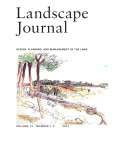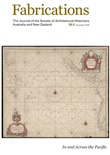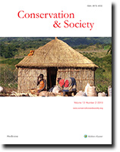
Landscape Journal
Scope & Guideline
Bridging Environmental Science and Architecture
Introduction
Aims and Scopes
- Interdisciplinary Research:
The journal fosters a diverse range of research methodologies, integrating perspectives from ecology, sociology, urban planning, and design to enrich the understanding of landscape architecture. - Social Justice and Equity:
A core focus is on examining issues of equity and justice within landscapes, exploring how design can address social disparities and promote inclusivity. - Sustainable Practices and Resilience:
The journal emphasizes sustainable landscape practices and the importance of resilience in the face of climate change, urbanization, and ecological degradation. - Cultural and Historical Contexts:
Research often delves into the historical and cultural narratives that shape landscapes, providing insights into how past practices influence contemporary design. - Innovative Design Approaches:
The journal showcases innovative design methodologies, including the use of technology, participatory design, and creative practices that challenge traditional landscape architecture paradigms.
Trending and Emerging
- Impact of Climate Change on Landscapes:
There is a growing emphasis on research that addresses the effects of climate change on landscape design and management, highlighting the need for adaptation and resilience strategies. - Community Engagement and Participatory Design:
Recent studies increasingly focus on community involvement in landscape architecture, advocating for participatory design processes that empower local populations and enhance social cohesion. - Health and Wellbeing in Landscape Design:
The integration of mental health and wellbeing considerations into landscape architecture is becoming more prominent, reflecting a broader understanding of the role of landscapes in promoting community health. - Technology and Digital Tools in Landscape Architecture:
A notable trend is the incorporation of technology, including GIS and virtual reality, in landscape design processes, enabling innovative approaches to planning and visualization. - Environmental Justice in Landscape Architecture:
There is an emerging focus on environmental justice, exploring how landscape architecture can address issues of inequality and access to green spaces, particularly in urban settings.
Declining or Waning
- Historical Landscape Studies:
While historical analyses of landscapes were previously common, recent publications suggest a decline in this focus as the journal shifts towards contemporary applications and practices. - Traditional Landscape Aesthetics:
The exploration of conventional landscape aesthetics appears to be diminishing, with fewer papers discussing purely aesthetic considerations without linking them to broader social or ecological implications. - Narrowly Defined Urban Studies:
Research that strictly pertains to urban landscapes without considering their ecological or social context is less prevalent, indicating a broader interdisciplinary approach is now favored. - Static Landscape Design Theories:
The journal seems to be moving away from static theories of landscape design, favoring dynamic and adaptive approaches that respond to changing environmental and social conditions.
Similar Journals

Entorno Geografico
Championing Open Access to Geographical ResearchEntorno Geográfico is a premier open-access journal published by University of Valle, dedicated to the field of geography and environmental studies. Since its inception in 2002, this journal has provided a dynamic platform for researchers, professionals, and students to disseminate innovative findings and engage in critical discussions regarding geographical phenomena and environmental challenges. With an ISSN of 1692-0074 and an E-ISSN of 2382-3518, it is recognized for its commitment to high-quality peer-reviewed content that reflects cutting-edge research trends within the discipline. The journal aims to enhance understanding of socio-environmental processes and contribute to the formulation of sustainable solutions to pressing geographical issues. By fostering an open-access model, Entorno Geográfico ensures that valuable knowledge is widely accessible, encouraging collaboration and advancing education in the field. Located in Cali, Colombia, the journal reflects a strong regional focus while embracing a global perspective, making it an essential resource for the international geography community.

Anthropocene Coasts
Navigating the Challenges of the Anthropocene CoastlineAnthropocene Coasts is a pivotal peer-reviewed journal published by SpringerNature, dedicated to advancing the interdisciplinary understanding of coastal systems in the context of the Anthropocene epoch. Since its inception in 2018, the journal has focused on critical issues at the intersection of Nature and Landscape Conservation, Ocean Engineering, Oceanography, and Waste Management and Disposal, achieving an impressive Q2 ranking in all these categories as of 2023. With a country of origin in Canada, this journal not only addresses significant environmental challenges, but also promotes innovative solutions and sustainable practices that resonate globally. Researchers, professionals, and students engaged in marine science, environmental studies, and engineering will find valuable insights and cutting-edge research disseminated through this open-access platform. By fostering collaboration and knowledge-sharing, Anthropocene Coasts empowers its audience to contribute to the sustainable management of coastal environments in an era of rapid change.

Interiors-Design Architecture Culture
Fostering Dialogue Between Design, Culture, and SpaceInteriors - Design Architecture Culture is a prominent academic journal dedicated to exploring the multi-dimensional relationship between interiors, design, and architecture, while also emphasizing their cultural significance. Published by Routledge Journals, Taylor & Francis Ltd, this journal serves as an essential platform for innovative research in the fields of architecture, cultural studies, and visual arts. The journal, which has been disseminating vital findings since its inception in 2010, plays a crucial role in fostering interdisciplinary discourse, and it currently holds a Q4 rank in Architecture and Cultural Studies, alongside a Q3 rank in Visual Arts and Performing Arts. Though it operates under a traditional access model, the journal's rigorously peer-reviewed articles are vital for researchers, professionals, and students alike, contributing to an enriched understanding of how interior spaces shape, and are shaped by, cultural dynamics. With an ISSN of 2041-9112 and E-ISSN of 2041-9120, the journal continues to make significant contributions to the academic discourse surrounding the design and cultural narratives of interior spaces.

International Journal of Taiwan Studies
Exploring Taiwan's Rich Tapestry of Culture and PoliticsInternational Journal of Taiwan Studies, published by BRILL, stands at the forefront of scholarly research on Taiwan, encompassing a broad spectrum of disciplines including Anthropology, Cultural Studies, History, Political Science, and more. With an ISSN of 2468-8797 and an E-ISSN of 2468-8800, this journal serves as a vital platform for researchers and professionals to explore Taiwan's multifaceted identity and its implications on contemporary global issues. As of 2023, it holds a commendable position within academic ranks, reflecting its impact with quartiles ranging from Q1 to Q3 across several categories. The journal is particularly noted for its contributions to Visual Arts and Performing Arts, ranking in the 85th percentile within the field. With its potential for open access options and commitment to innovative scholarship, the International Journal of Taiwan Studies is an invaluable resource for those seeking to deepen their understanding of Taiwanese society, culture, and politics, while engaging with an ever-evolving scholarly conversation.

TUEXENIA
Transforming insights into action for a healthier planet.TUEXENIA is a prominent academic journal dedicated to advancing the fields of Ecology, Management, Monitoring, Policy and Law, Nature and Landscape Conservation, and Plant Science. Published by the Floristisch-Sozioogischen Arbeitsgemeinschaft e.V. in Germany, this journal has established itself as a pivotal resource for researchers, professionals, and students alike since its inception in 1985, with a continued commitment to scholarly excellence through 2024. Distinguished by its consistent Q3 quartile rankings across several related categories in 2023, TUEXENIA serves as a vital platform for the dissemination of innovative research and practical applications that address the pressing challenges in environmental science. While it currently does not support an open-access model, the journal's compelling content is crucial for those seeking to deepen their understanding and contribute to impactful discussions in ecology and conservation. With an increasing audience on platforms like Scopus, TUEXENIA is instrumental in bridging the gap between research and real-world environmental management, making it an essential read for anyone engaged in these dynamic fields.

ARQ
Exploring innovative horizons in architecture and the arts.ARQ, published by the Pontificia Universidad Catolica de Chile in the School of Architecture, is a pioneering open access journal established in 2001 that significantly contributes to the fields of architecture, conservation, and the visual and performing arts. Based in Santiago, Chile, this journal provides a vital platform for disseminating innovative research and critical discourse, showcasing diverse perspectives from scholars and professionals alike. With its impact evident in its prestigious Scopus rankings—placing it within the 44th percentile of Visual Arts and Performing Arts, the 26th percentile in Conservation, and the 23rd percentile in Engineering Architecture—ARQ demonstrates a commitment to elevating discourse within its discipline. The journal’s current categorization into different quartiles reflects its evolving scope and its aim to engage with contemporary challenges in architecture and related fields. Additionally, ARQ offers comprehensive open access options that enhance visibility and accessibility for its readership, fostering a collaborative and informed academic environment.

Fabrications-The Journal of the Society of Architectural Historians Australia and New Zealand
Illuminating the Interplay of Architecture and CultureFabrications - The Journal of the Society of Architectural Historians Australia and New Zealand is a vital scholarly platform that explores the rich interplay between architecture and its historical context within the Australasian landscape. Published by Routledge Journals, Taylor & Francis Ltd, this journal serves as a crucial resource for researchers, professionals, and students in the fields of architectural history, urban studies, and visual arts. With an ISSN of 1033-1867 and an E-ISSN of 2164-4756, Fabrications has received recognition for its quality, placing in the Q4 category in Urban Studies and Q2 in Visual Arts and Performing Arts as of 2023. This journal not only welcomes innovative research articles but also encourages the exploration of New Zealand and Australian cultural heritage through diverse architectural narratives. With publications spanning significant years since its inception in 1989, Fabrications continues to provide an open forum for dialogue and discovery, catering to the academic and professional community's growing interest in architectural narratives through a regional lens.

LANDSCAPE ECOLOGY
Connecting Ecology, Geography, and ConservationLANDSCAPE ECOLOGY, published by SPRINGER, is a premier journal dedicated to the field of landscape ecology, bringing together innovative research that intersects ecology, geography, and conservation. With a prestigious history since its inception in 1987, this journal showcases high-impact studies reflected in its impressive 2023 rankings in the first quartile of Ecology, Geography, Planning and Development, and Nature and Landscape Conservation categories. Operating from the Netherlands, LANDSCAPE ECOLOGY serves as a critical platform for scholars and practitioners aiming to advance their understanding of spatial analysis, environmental challenges, and landscape management. While the journal operates on a traditional access model, the quality and rigor of published research ensure it remains a vital resource for the academic community, inspiring a deeper exploration of our dynamic natural environments and the socio-ecological interactions within them.

Conservation & Society
Advancing ecological knowledge for a sustainable future.Conservation & Society is a distinguished open-access journal published by Wolters Kluwer Medknow Publications, dedicated to advancing research in the fields of ecology, environmental science, and conservation policy. With an ISSN of 0972-4923 and an E-ISSN of 0975-3133, this journal serves as a vital platform for scholars and practitioners from around the globe to disseminate innovative findings and insights related to conservation efforts, landscape management, and ecological sustainability. Currently maintaining a commendable Q2 ranking across several categories, including Ecology and Nature Conservation, Conservation & Society is recognized for its significant contribution to the scientific community, supported by its extensive indexing in Scopus and a growing impact factor. Since achieving open-access status in 2003, the journal has fostered a vibrant exchange of ideas, allowing for unrestricted access to vital research that shapes environmental policies and practices. Researchers, professionals, and students interested in the latest developments and solutions for environmental challenges are encouraged to explore the rich content this journal offers, making it an essential resource in the rapidly evolving field of conservation.

Manzar-The Scientific Journal of Landscape
Fostering Dialogue on Landscape DynamicsWelcome to Manzar - The Scientific Journal of Landscape, a premier academic outlet focusing on the interdisciplinary exploration of landscape studies, offering insights into art, architecture, and urbanism. Published by the NAZAR RESEARCH CENTER, this journal has been an Open Access platform since 2009, fostering free exchange of knowledge and supporting the dissemination of research in landscape architecture and urban studies. Renowned for its commitment to advancing scholarly dialogue, Manzar provides an essential resource for researchers, professionals, and students captivated by the complexities and aesthetics of landscapes. With an ISSN of 2008-7446 and E-ISSN of 2008-2169, the journal presents a diverse range of articles that investigate the interactions between natural and built environments. Located in Tehran, Iran, Manzar not only enhances local discourse but also contributes globally to the field of landscape studies.